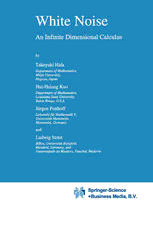
White Noise: An Infinite Dimensional Calculus PDF
Preview White Noise: An Infinite Dimensional Calculus
White Noise Mathematics and Its Applications Managing Editor: M. HAZEWINKEL Centre for Mathematics and Computer Science, Amsterdam, The Netherlands Volume 253 White Noise An Infinite Dimensional Calculus by Takeyuki Hida Department ofM athematics, Meijo University, Nagoya, Japan Hui-Hsiung Kuo Department of Mathematics, Louisiana State University, Baton Rouge, US.A. Jtirgen Potthoff Lehrstuhl./Ur Mathematik V, Universitiit Mannheim, Mannheim, Germany and Ludwig Streit BiBos, Universitiit Bielefeld, Bielefeld, Germany, and Universidade da Madeira, Funchal, Madeira SPRINGER-SCIENCE+BUSINESS MEDIA, B.V. A C.I.P. Catalogue record for this book is available from the Library of Congress. ISBN 978-90-481-4260-6 ISBN 978-94-017-3680-0 (eBook) DOI 10.1007/978-94-017-3680-0 Printed on acid-free paper AII Rights Reserved © 1993 Springer Science+Business Media Dordrecht Originally published by Kluwer Academic Publishers in 1993 Softcover reprint of the hardcover 1s t edition 1993 No part of the material protected by this copyright notice may be reproduced or utilized in any form or by any means, electronic or mechanical, including photocopying, recording or by any information storage and retrieval system, without written permission from the copyright owner. To Minami, Fukuko, Tomiko, Clara and Jan Contents 1. GauBBian Spaces ................................................................................................ 1 2. <J' and ':I Transformation and the Decomposition Theorem ............................... 10 3. Generalized Functionals ................................................................................... 35 3.A The Spaces (L2)± ......................................................................................... 36 3.B Triples of Functional Spaces .......................................................................... 52 3.C Constructions with Second Quantized Operators ........................................... 61 4. The Spaces (':I) and (':1)* ........................................•......................................... 74 4.A Basic Properties and Examples ..................................................................... 74 4.B Positive Generalized Functionals ................................................................ 109 4.C Characterization Theorems and Applications ............................................... 119 4.D Analytic Version o£ (1) and Growth Estimates .......................................... 136 5. Calculus of Differential Operators .................................................................. 146 5.A Pointwise Calculus of Differential Operators ............................................... 147 5.B Differential Operators on (1) ....................................................................... 154 5.C Differential Operators and Their Adjoints on (L2) and (1)* ........................ 163 5.D Table of Rules ............................................................................................ 179 6. Laplacian Operators ...................................................................................... 184 6.A White Noise Kernel Operators ..................................................................... 184 6.B The Number Operator ................................................................................. 196 6.C The Gross and Volterra Laplacians ............................................................. 199 6.D The Levy Laplacian .................................................................................... 211 6.E The Commutation Relations ....................................................................... 228 viii Contents 7. The Spaces '!J) and '!J)* •••••••••••••••••••••••••••••••••••••••••••••••••••••••••••••••••••••••••••••••••••• 232 7.A The Ornstein-Uhlenbeck Semigroup ........................................................... 233 7.B Littlewood-Paley-Stein Inequalities ............................................................ 249 7.C Meyer's Inequalities and Their Applications ................................................ 263 8. Stochastic Integration .................................................................................... 277 8.A Introduction ................................................................................................ 277 8.B Integrals of Ito Type ................................................................................... 283 8.C Stochastic Integrals with Anticipating Integrands ........................................ 289 8.D Properties of Anticipating Stochastic Integrals ............................................ 300 9. Fourier and Fourier-Mehler Transforms ......................................................... 317 9.A A Heuristic Motivation ............................................................................... 318 9.B Definition and Examples of the Fourier Transform ...................................... 319 9.C Elementary Properties ................................................................................. 324 9.D The Fourier Transform as an Adjoint Operator ........................................... 332 9.E A Characterization of the Fourier Transform ............................................... 336 9.F Relations with Laplacians, Wick Products, and Convolutions ...................... 339 9.G Relation with the Finite Dimensional Fourier Transform ............................ 348 9.H Fourier-Mehler Transforms ........................................................................ 356 10. Dirichlet Forms ........................................................................................... 366 10.A Construction of Energy Forms over !fl (lR) .................................................. 367 10.B Closability, and the Associated Diffusion Processes .................................... 382 11. Applications to Quantum Field Theory ........................................................ 399 11.A Introduction .............................................................................................. 399 l1.B Free Fields ................................................................................................ 405 l1.C Interacting Fields and the Role of <p - Bounds .......................................... 418 Contents ix 12. Feynman Integrals ....................................................................................... 435 12.A Construction of the Feynman Integrand: Free Particles ............................ 436 12.B Construction of the Feynman Integrand: Interacting Particles .................. .439 12.C Manipulating the Feynman Integrand: Schwinger's Variational Principle .. .448 Appendices ........................................................................................................ 451 A.l Hermite Polynomials .................................................................................. 451 A.2 Fock Space ................................................................................................. 456 A.3 Reproducing Kernel Hilbert Spaces ............................................................. 468 A.4 Frechet and Gateaux Derivatives on !f(lRd) •..•..•..••.•..•.•.....•.•.•...••••.•.•.•.•..•••. 472 A.5 Topologies on !f(lRd) and !fl (IR) .•..•...•.••.•...•.•...••.......•.••...•.•..•..•.•.•.....••..•...•. 477 Bibliography ..................................................................................................... 486 Notations and Conventions ................................................................................ 507 Index ................................................................................................................. 513 Preface Many areas of applied mathematics call for an efficient calculus in infinite dimensions. This is most apparent in quantum physics and in all disciplines of science which describe natural phenomena by equations involving stochasticity. With this monograph we intend to provide a framework for analysis in infinite dimensions which is flexible enough to be applicable in many areas, and which on the other hand is intuitive and efficient. Whether or not we achieved our aim must be left to the judgment of the reader. This book treats the theory and applications of analysis and functional analysis in infinite dimensions based on white noise. By white noise we mean the generalized Gaussian process which is (informally) given by the time derivative of the Wiener process, i.e., by the velocity of Brownian mdtion. Therefore, in essence we present analysis on a Gaussian space, and applications to various areas of sClence. Calculus, analysis, and functional analysis in infinite dimensions (or dimension-free formulations of these parts of classical mathematics) have a long history. Early examples can be found in the works of Dirichlet, Euler, Hamilton, Lagrange, and Riemann on variational problems. At the beginning of this century, Frechet, Gateaux and Volterra made essential contributions to the calculus of functions over infinite dimensional spaces. The important and inspiring work of Wiener and Levy followed during the first half of this century. Moreover, the articles and books of Wiener and Levy had a view towards probability theory. Almost from its very beginning quantum physics has been using infinite dimensional calculus and it became an important (though sometimes informal) tool in modern theoretical and mathematical physics through the pioneering work of Berezin, Cook, Feynman, Fock, Schwinger, and Segal. During the sixties and seventies, in the context of Euclidian and constructive quantum field theory, many structures and deep results in infinite dimensional analysis have been worked out by Albeverio and H~egh-Krohn, Glimm and Jaffe, Gross, Nelson, Simon, and xi
